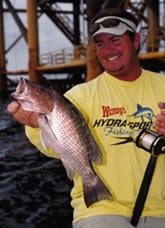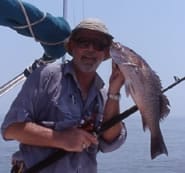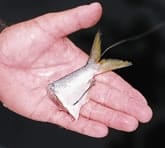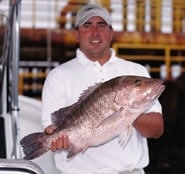
| Gray Area: Louisiana’s West Delta is loaded with shallow-water platforms that hold large schools of gray snapper such as this one taken by Capt. Brandon Ballay. |
As we loaded our gear into Captain Brandon Ballay’s 28-foot Hydra-Sports, we had no way of knowing that the rapidly disappearing patch of blue sky above us would be the last we’d see of it that day. But the water in the marina was calm, and I was wired with anticipation inspired by the focus of our upcoming trip – chunking for gray snapper.
I had caught several grays in the past, but most were taken incidentally while fishing deep for their red cousins. Brandon had assured me that this trip, which would involve “chunking ’em up,” would be much more entertaining and a lot less tiring than working the depths with heavy gear. Captain Damon McKnight, a mutual friend and fan of gray snapper who was along for the ride, agreed whole-heartedly.
Chunk ‘Em Up!
By the time we cleared the mouth of Louisiana’s Tante Phine Pass, the sky was completely overcast, but the light winds made for a quick and comfortable ten-mile run to a platform in Block 58. We tied off to the structure, rigged up, and Brandon began chunking with pieces of menhaden (pogies) about half the size of one’s little finger. Soon a veritable cloud of pinkish-gray forms materialized in the green water between our boat and the platform.

The author displays a fine gray snapper that ate a pogy chunk drifted with the chum.|
Damon hooked up almost immediately, but lost the fish when it dived into the platform’s substructure, a problem that I soon discovered was not easily remedied! However, by locking down his drag and moving quickly aft following his next bite, Damon was able to prevent the fish from reaching the line-shredding structure, and soon boated a lovely seven-pounder.
Thus began a very enlightening morning of snapper fishing that saw us hopping from platform to platform in West Delta Block 58, the 30s and the 40s. Virtually every one held snapper, and if we couldn’t catch them, at least we saw them as they came up to snack on the chum. By the time our box of pogies ran dry, our supply of hooks (and in my case, flies) had been decimated and my two-piece fly rod had been converted to a three-piece travel model. However, I had learned a few things about this largely under-appreciated species, including how tough they are!
The “Sleeper” Snapper
While gray snapper appear regularly in the catches of Louisiana fishermen targeting other species, they arelargely ignored by anglers, who may not realize that these great-tasting, hard-fighting fish can be taken in relatively shallow water. Indeed, Brandon has caught them at the big platform in West Delta Block 84, which stands in about 20 feet of water.
| ### Where to Find ThemThere are plenty of platforms in West Delta, as well as other areas, that hold or should hold gray snapper. The platforms in the 30s, 40s, and 50s, plus the northernmost platforms in Block 79, are among Brandon Ballay’s favorite snapper haunts, and there are often plenty of fish around the satellite wells on the south edge of the East Bay field. Further to the west, the South Timbalier Block 21 and Block 37 fields, both accessible from Fourchon and Leeville, and are noted for holding gray snapper. – Pete Cooper, Jr. |
The platforms we fished stood in water ranging from just under 50 feet to around 60 feet. But judging by how quickly the fish responded to the chunks, they must have been suspended fairly near the surface. Indeed, in past years I have seen them plainly from the deck of a bay boat not ten feet down around the Block 58-C platform.
Brandon’s method of chunking plays a large role in his success with these normally wary fish. He begins by tying off to or anchoring near one of the platform’s down-current corner legs, which create an eddy of sorts where the snapper can maintain their position without expending a lot of energy. He then tosses out four or five pieces of menhaden at a time, scattering them around the base of the leg. His initial tosses are quite forceful, and are designed to create a ruckus that draws the snappers’ attention.
Once the fish respond, Brandon doles out the chunks in a more conventional manner. Notably, the chunks are distributed much faster than they are when chunking for tuna, the time between tosses being only slightly longer than it takes to cut the four or five pieces of menhaden. The frequent tosses are necessary to provide ample enticement for the snapper before the inevitable horde of bait-stealers gobble up all the chunks.
Tails Are It

Pogy tails make the best baits and keep the triggerfish at bay.|
While menhaden heads and bodies are the preferred chunking material, Brandon uses the tail sections for bait. He passes the hook completely through the caudal peduncle (the narrow part of the tail), buries the point next to the cut, then gently pulls on the line so that the shank lays parallel to the bait’s backbone. The purpose of the tail section is not to give the snapper a larger, more appealing meal, but to deter bait-stealers such as small triggerfish, which often become such a nuisance that they drive away snapper and snapper fishermen alike!
On that note, gray snapper seem to be more inclined to take a bait after they first appear. Once they learn that something isn’t quite right with the baits, they become almost uncatchable. Of course, new fish may appear on the scene throughout the party, but once the majority develop lockjaw, you’re often better served by moving to a platform inhabited by “ignorant” fish.
Bait presentation is fairly basic. Flip your morsel into the swarm of snapper and allow it to sink and drift with the current at the same rate as the chunks. Let it drift until it either gets eaten or begins to drag in the current, then pick it up for another cast. Once the bait begins to drag, the snapper will rarely have anything to do with it.

Capt. Damon McKnight shows off a fat snapper he managed to keep away from the legs of a platform in 50 feet of water.|
To present the small, light tail sections, Brandon uses seven-foot casting rods with very fast tips and stout butt sections. The reels are loaded with 50-pound mono, which is tied directly to the hooks. The hooks are made of heavy wire and are small enough to bury the point in the rather small bait.
Bon Appetit!
Gray snapper are strong, but even fish over ten pounds can be boated on the kind of gear Brandon uses. Watching a big snapper ease up to your bait and inspect it is guaranteed to increase your pulse rate. But gray snapper and the chunking technique have a few more perks in store.
| ### Gray Guides & SuppliesTo book a gray snapper chunking trip with Captain Brandon Ballay call, (985) 534-9246. To book a trip with Captain Damon McKnight, call (800) 318-1720. Both men fish from big, fast Hydra-Sports boats, and both run out of the Venice Marina, (985) 534-9357, which sells boxes of frozen menhaden. – Pete Cooper, Jr. |
For one thing, there is none of the drudgery associated with fishing for red snapper. Also, the possession limit is much greater than it is for red snapper: ten per day with a minimum size of 12 inches. And I seriously doubt any Louisiana cook – professional or otherwise – can tell the difference between the two, whether they are fried, grilled or broiled.
Gray snapper are certainly not a “new” game and food species in Louisiana waters, but they deserve more attention. Their sizeable numbers, vulnerability to chunking, and accessibility create an opportunity that few anglers should ignore, especially on days when the other species aren’t cooperating. Give ’em a try!









